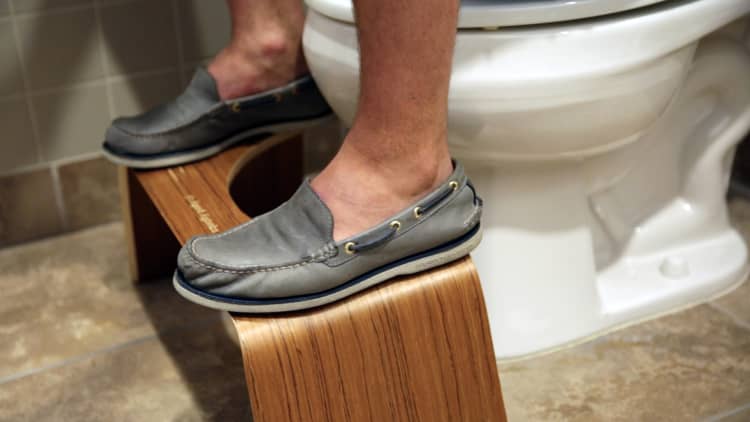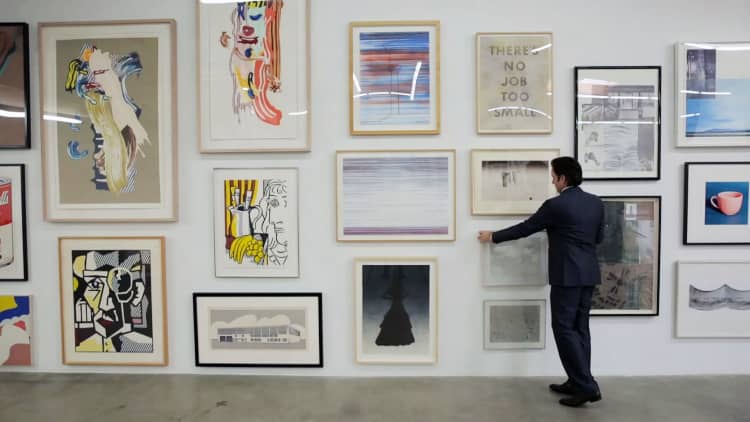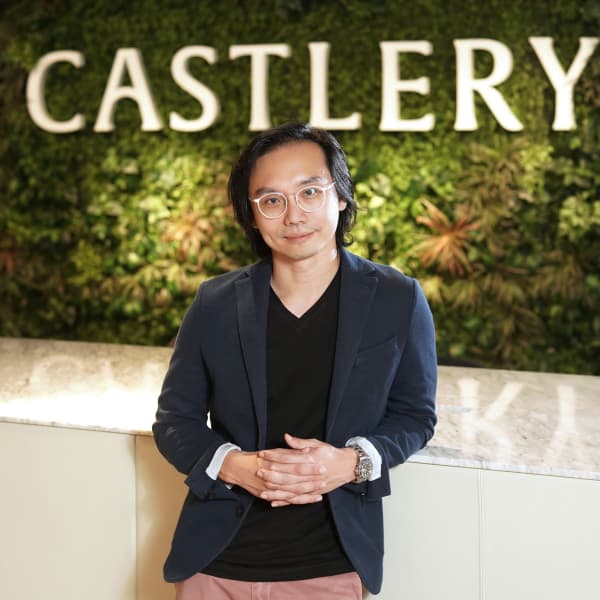In 1994, Peter Loughrey sat in a hospital bed at the National Institutes of Health with tubes running in and out of his body. He was being treated for a rare form of lymphoma, and the odds of his survival weren't good.
"I swore if I got out of this, if I beat this lymphoma, I'm going to be the best art dealer I can be," he said.
More than 20 years later, Loughrey runs Los Angeles Modern Auctions, or LAMA. Last year he auctioned off $12 million in art, earning commissions of around $2 million.
Loughrey went from Hollywood stunt man to homeless guy to cancer patient to successful art entrepreneur, and the story is even weirder than it sounds.
From death wish to stunt man
Loughrey says his eye for art came through "osmosis," as his parents dragged him and his brother to galleries and antique stores while growing up outside Baltimore. He had no interest in making art a career. "I came out to Los Angeles ostensibly to become a stunt man."
He had been a daredevil as a kid, and his mother was so concerned about his "death wish," she sent him to a psychiatrist.
"The psychiatrist told me about Mike Tyson," he said. The doctor explained how Tyson found the right people to guide his talent for fighting into something he could do for a living.
"What does that have to do with me?" Loughrey asked.
The doctor replied, "Well, you're crazy about driving cars and wrecking cars. Maybe you could be a stunt man."
For Loughrey, "a lightbulb went off in my head," so he told his mother, "Mom, I didn't want to see this guy, but you're so right. I'm dropping out of school and going to L.A. to be a stunt man." His mother was not pleased.
From Hollywood to homeless
Like many before him, Loughrey learned it's difficult to succeed in Hollywood when you don't know anyone. He made a little money doing stunt work, but it was boring, and he was broke.
He was living in a van in Marina del Rey, where he managed to get a key to a boathouse shower. He'd spend his days relaxing by the pool at a nearby apartment complex. Even though he was homeless, "I lived better than many millionaires," he said.
He also had a lot of free time on his hands, and he started thinking about his knowledge of art. "I found that out here, a lot of people didn't know what antiques were and what a good antique was, and I started trusting my eye and buying things and flipping them."
People in Beverly Hills would leave discarded furniture on the sidewalk once a month for a truck to pick up. "I would just get there before those trucks did," he said. "This was before 'Antiques Roadshow,' before eBay. It was before anybody really knew what to do with an old vintage piece."
Loughrey's brother, Joe, was also in Los Angeles by then, so he would store pieces he found in Joe's garage (or his own van) until he could find a dealer to buy them. "You could find things by Frank Lloyd Wright and Charles Eames," he said. "People were still throwing these things away."
Eventually, the two brothers opened their own gallery. When they built up too much inventory, Loughrey held his first auction when he was just 24 years old.
"The first auction was standing room only," he said. "I had to place a porter out on the sidewalk to take bids and then yell them in the front door."
Another light bulb went off. "I immediately knew, 'Wow, I don't want to do retail anymore. I want to be an auctioneer.'"
But the gallery closed in 1993, when Joe died of AIDS. It was time to figure out the next act.
From health scare to happiness
What happened next included a strange detour when Loughrey became a marketing director for a medical device company in Philadelphia.
"My father had invested in the company, and I was on a conference call because I gave him an idea," Loughrey said. The company was seeking FDA approval for a heart rate monitor, but approval was taking a long time, and the company needed to make some money. "I said, 'Well, can you use it on animals?'"
Turned out the heart rate monitor didn't need FDA approval for animal use, and the product suddenly found a lucrative market from pets to racehorses. "They wound up selling a tremendous number of units."
Then, 10 months after moving to Philadelphia to join the company, Loughrey was diagnosed with a rare form of lymphoma, which landed him at the National Institutes of Health. That is where he reconnected with a childhood friend who was working as a budget analyst there. They would soon fall in love.
"When Peter was in the hospital, he had a poster on his wall," Shannon Loughrey remembers. It was a poster of a thousand chairs, and she recalls him explaining to her the characteristics of each one. "I would see the passion, and I would see his interest in modern design. ... I kept trying to encourage him, 'You should go back to do this.'"
He did. With her. He beat cancer, and they got married.
From dismissed to respected
In 1995, he and Shannon came back to Los Angeles. She soon got a job to pay the bills while he spent $20,000 of their money to set up Los Angeles Modern Auctions. There was less competition for art auctions on the west coast, and he was optimistic.
However, they couldn't make any money. The market did not yet appreciate the Mid-Century Modern era as much as Loughrey did. "I would be making somewhere between $25,000 and $60,000 (in commissions) on an auction, but that auction would cost me $80,000 to $100,000 to produce."
More than once Shannon came home from work to find their couch missing. "Peter's like, 'Oh yeah, someone came over and I sold it. But look, we have this money!' And I'm like, 'But where's my couch?'"
Then the internet happened. "All of a sudden, it wasn't just a couple hundred enthusiasts locally, it was thousands globally." By 1999, LAMA was turning a profit.
Over the past two decades, the Loughreys have auctioned off more than $100 million in art. About 10 years ago they moved into their current large warehouse in the San Fernando Valley, a building where Stan Winston used to build dinosaurs for "Jurassic Park" and created the Iron Man suit.
"We've never had any debt, never taken any outside investment," Loughrey said.
His reputation as an expert skyrocketed a few years ago when he proved a painting by New York pop artist Keith Haring was real. Art verification authorities didn't believe it. Then Loughrey discovered a thumbprint in wet paint on the back of the painting.
Haring had been arrested several times in the '80s for putting up posters in New York subways, so Loughrey petitioned the NYPD for a copy of the artist's fingerprints. He succeeded, and a forensic expert pronounced the thumbprint a perfect match. "That was fun."
The next wave
Loughrey has always been attracted to mid-century art because it reflects a time when America became the world's greatest power. "There is a kind of intense optimism about post World War II American art," he said. "And a lot of those artists were working here in Southern California."
His advice to a new generation of art entrepreneurs, however, is to become an expert in an era that is currently undervalued. "Look at the 1970s and 1980s, because no one is looking at that work very critically yet, and there are incredible opportunities."
When we met earlier this year at their warehouse, the Loughreys were preparing for an auction that would include several pieces ranging from $1,500 to $250,000. There was a Warhol, a David Hockney print that the artist created on an iPad, and we sat during our interview on Sam Maloof bar stools once owned by Gene Kelly.
But Loughrey wistfully recalled one piece he should have kept. "There's a chaise lounge designed by Marc Newson, an Australian designer," he said. Newson made 10 of the lounges in the '80s, and Loughrey bought one for $110,000 hoping to make a relatively quick profit.
No one was interested.
A few years later, Loughrey sold the chaise lounge for $121,000, earning a 10 percent return. "Today they are selling for $2.5 million, $3 million, so I kind of regret not holding on to that piece."
Like this story? Like CNBC Make It on Facebook
Don't miss: How this guy turned frozen pickle juice into a business with over $200,000 in sales







